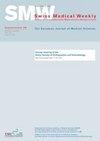较新的植入式连续血糖监测系统(Eversense® CGM 系统)对糖尿病控制和患者报告结果的影响:单中心回顾性和前瞻性观察研究
IF 2.1
4区 医学
Q2 MEDICINE, GENERAL & INTERNAL
引用次数: 0
摘要
研究目的:Eversense® CGM 系统是首款也是唯一一款使用完全皮下植入式传感器的连续血糖监测系统 (CGMS)。本研究旨在评估在真实临床环境中使用 Eversense® CGM 系统的有效性、安全性和患者报告的结果,在瑞士一家糖尿病中心(Luzerner Kantonsspital)进行评估,并进行长期随访。方法:这是一项前瞻性和回顾性观察研究,研究对象包括在 2017 年至 2022 年期间植入至少一个 Eversense® 血糖传感器的 1 型糖尿病患者。主要终点是植入传感器后,从基线(植入传感器前)到6±2个月和12±2个月以及最后一次随访(最新可用值)期间的HbA1c水平变化。次要结果指标为传感器过早损坏的次数、与植入过程相关的不良事件(感染、出血、植入或拆卸困难)以及与患者相关的结果(通过问卷进行评估)。中位随访时间为 50 个月(IQR 22.3-58.5)。总共植入了 178 个传感器。有 26 名参与者获得了有效的 HbA1c 结果。与基线值相比,6 个月、12 个月和最后一次随访时的 HbA1c 水平变化分别为-0.25%、-0.45 和-0.2(p = 0.278、0.308 和 0.296)。我们记录了 16 次(9%)传感器过早故障,均发生在 2019 年至 2020 年期间。除了一次晚期感染和四次复杂的传感器拆卸外,没有评估出重大并发症。问卷调查结果显示,低血糖发生率有了主观改善,对低血糖有了更好的认识,对糖尿病管理有了更好的印象。患者报告的设备常见问题是技术错误(连接问题)和拆卸程序问题:结论:使用 Eversense® CGM 系统后,HbA1c 的变化在 -0.2% 到 -0.45% 之间。传感器过早损坏的比率很低。除了一例感染和四例复杂的移除之外,传感器植入或移除后没有出现重大并发症。Eversense® CGM 系统的患者报告结果显示,该系统对低血糖发生率产生了主观上的积极影响,患者对控制低血糖和糖尿病有了更大的信心,而且发射器和移动应用程序易于操作。技术问题是必须考虑的,但随着最新一代传感器的使用,如今技术问题已非常罕见。本文章由计算机程序翻译,如有差异,请以英文原文为准。
Impact on diabetes control and patient-reported outcomes of a newer implantable continuous glucose monitoring system (Eversense® CGM System): a single-centre retro- and prospective observational study
AIMS OF THE STUDY: The Eversense® CGM System is the first and only continuous glucose monitoring system (CGMS) that uses a fully subcutaneous implanted sensor. This study aimed to evaluate effectiveness, safety and patient-reported outcomes in patients using the Eversense® CGM System in a realistic clinical setting, assessed at a single Swiss diabetes centre (Luzerner Kantonsspital) with prolonged follow-up.
METHODS: This was a prospective and retrospective observational study that included patients with type 1 diabetes mellitus in whom at least one Eversense® glucose sensor was implanted between 2017 and 2022. The primary endpoint was the change in HbA1c levels from the baseline (before implantation of the sensor) to 6 ± 2 and 12 ± 2 months and the last follow-up (newest available value) after implantation. The secondary outcome measures were the number of premature sensor breakdowns, adverse events related to the implantation procedure (infection, bleeding, difficulties with implantation or explantation) and patient-related outcomes (assessed with a questionnaire).
RESULTS: A total of 33 patients participated in this study. The median follow-up time was 50 (IQR 22.3–58.5) months. In total, 178 sensor implantations were performed. Valid HbA1c results were available for 26 participants. Compared to the baseline values, HbA1c levels at 6 and 12 months and the last follow-up changed by –0.25%, –0.45 and –0.2 (p = 0.278, 0.308 and 0.296, respectively). We recorded 16 (9%) premature sensor breakdowns, all occurring between 2019 and 2020. Apart from one late-onset infection and four complicated sensor removals, no major complications were assessed. The results of the questionnaire showed a subjective improvement in hypoglycaemia rates, a better perception of hypoglycaemia and the impression of better diabetes management. Common issues with the device reported by the patients were technical errors (connection problems) and problems with the removal procedure.
CONCLUSIONS: The use of the Eversense® CGM System resulted in changes in HbA1c of between –0.2% and –0.45%. The rate of premature sensor breakdown was low. Major complications following sensor implantation or removal were absent, apart from one case of infection and four cases of complicated removal. Patient-reported outcomes with the Eversense® CGM System showed a subjective positive impact on hypoglycaemia rates, greater confidence in managing hypoglycaemia and diabetes in general, and easy handling of the transmitter and mobile app. Technical issues must be considered but are nowadays, with the use of the newest sensor generation, very rare.
求助全文
通过发布文献求助,成功后即可免费获取论文全文。
去求助
来源期刊

Swiss medical weekly
医学-医学:内科
CiteScore
5.00
自引率
0.00%
发文量
0
审稿时长
3-8 weeks
期刊介绍:
The Swiss Medical Weekly accepts for consideration original and review articles from all fields of medicine. The quality of SMW publications is guaranteed by a consistent policy of rigorous single-blind peer review. All editorial decisions are made by research-active academics.
 求助内容:
求助内容: 应助结果提醒方式:
应助结果提醒方式:


